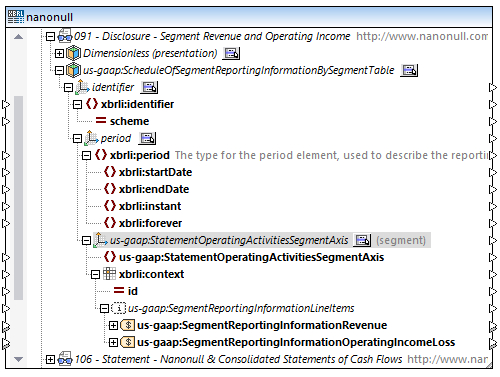XBRL Hypercubes
XBRL hypercubes enable automatic context handling. For more information about XBRL hypercubes, see the XBRL Dimensions 1.0 Specification. MapForce shows all hypercubes which have reportable concepts. If one of the related hypercube dimensions has no domain, it is not shown in the XBRL component.
Types of XBRL hypercubes
XBRL hypercubes can be of the following types:
•Defined by the taxonomy (e.g., ![]() ).
).
•Generated by MapForce to simplify the default dimensions identifier and period, derived from the Presentation linkbase (e.g., ![]() ).
).
•Generated by MapForce within the All concept node ![]() .
.
Every hypercube contains two default dimensions, identifier and period, that support the easy reading/writing of these two elements for each context. Additionally defined dimensions in the taxonomy are automatically related to the context elements xbrli:segment and xbrli:scenario.
Hypercubes denoted as Dimensionless (presentation) use both default dimensions. The hierarchical order of concepts shown within its context node is taken from the presentation linkbase.
Dimensionless hypercube items also use both default dimensions, but do not have any hierarchical concept order and show only the raw list of all concepts defined in the taxonomy.
All other hypercubes are defined within the taxonomy and are designated according to the name defined in the Label linkbase of the taxonomy.
Hypercubes and their dimensions (or Axes) have an ![]() icon which allows you to define the presentation of each of the dimensions in the component. The screen shot below shows a sample taxonomy file which contains both generated hypercubes and hypercubes defined by the taxonomy.
icon which allows you to define the presentation of each of the dimensions in the component. The screen shot below shows a sample taxonomy file which contains both generated hypercubes and hypercubes defined by the taxonomy.

In addition to concepts, any tuples which contain only items of the same hypercube are shown as children of the context node.